ACIDS, BASES AND SALTS for Class 7 SCIENCE
Introduction
Hum apni daily life mein bahut sare edible substances use karte hai like lemon, tamarind, common salt, etc. Inn sabhi substances ka apna ek taste hota hai. Kuchh sweet hote hai, kuchh sour hote hai, kuchh bitter hote hai aur kuchh salty hote hai. Iss chapter mein hum acids, bases aur salt ke bare mein padhenge, unki testing ke bare mein padhenge, unke taste ke bare mein padhenge. Hum daily life mein inn substances ke uses ke bare mein bhi padhenge. Iss chapter mein hum neutralisation reactions ke bare mein bhi padhenge.
Acids and Bases
Acids: Aise substances jinka sour taste hota hai unme acids present hote hai. Aise substances ka chemical nature bhi acidic hota hai. Acid word Latin word acere se bana hai jiska meaning sour hota hai. Aise sour substances mein jo acids present hote hai vo natural acids hote hai. Acids ke kuchh example hai- acetic acid, formic acid, citric acid, etc. Ab hum niche di hui figure mein kuchh acids ke name aur unke sources ke bare mein janege.
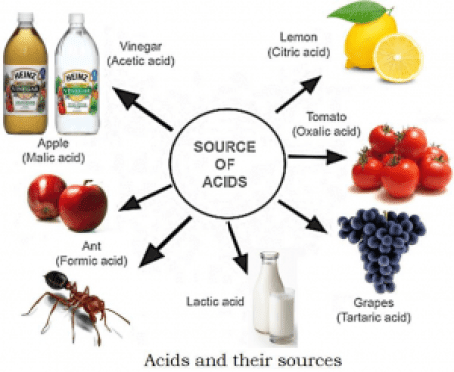
Bases: Aise substances jo touch karne par soapy hote hai aur bitter in taste hote hai unko bases kehte hai. Aise substances ka chemical nature basic hota hai. Bases ke kuchh examples hai- calcium hydroxide, magnesium hydroxide aur ammonium hydroxide etc. Inke sources bhi niche figure mein diye gaye hai.
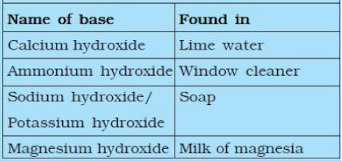
Lekin hum sab substances ko taste karke acids ya bases ka pata nahi laga sakte. Isko test karne ke liye kuchh special type ke substances ka use kiya jata hai. Aise substances ko indicators kehte hai. Agar hum indicators ko kisi bhi acidic ya basic solution mein dalte hai toh yeh apna colour change kar lete hai.
Natural indicators ke kuchh examples hai- turmeric, litmus, china rose petals, etc.
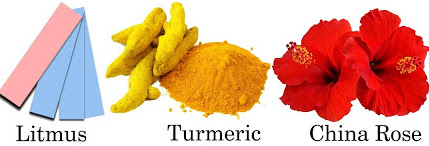
Natural indicators around us
Litmus: A natural dye
Litmus ek most commonly used natural indicator hai. Isko lichens se extract kiya jata hai. Yeh solution ya strips ke form mein available hota hai. Strips ke form mein hum isko litmus paper kehte hai. Litmus paper generally blue aur red litmus paper ke form mein present hota hai.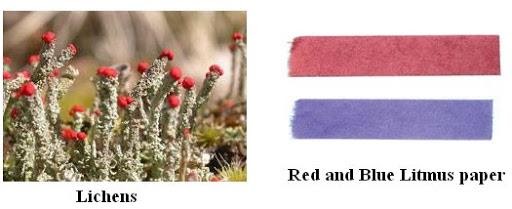
Solution ke form mein litmus distilled water mein purple colour ka hota hai. Jab isko acidic solution mein put karte hai toh yeh red colour mein change ho jata hai aur basic solution mein put karne par yeh blue ho jata hai.
Turmeric is another natural indicator
Turmeric ek bright yellow colour ka powder hota hai jo plant se milta hai. Isko hindi mein haldi bolte hai. Turmeric ek yellow colour ki dye hai jo basic solution mein red ho jata hai.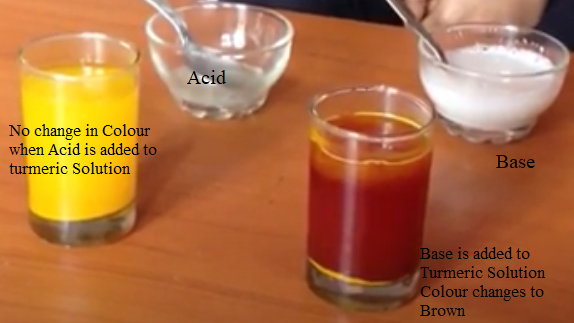
China rose as an indicator
China rose ek natural indicator hai. Hindi mein isko gudhal bhi kehte hai. Yeh china rose ke red flowers se extract kiya jata hai. Lekin isko extract kiya kaise jata hai?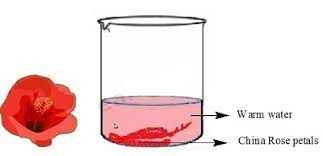
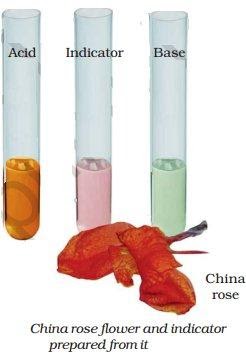
Acid rain
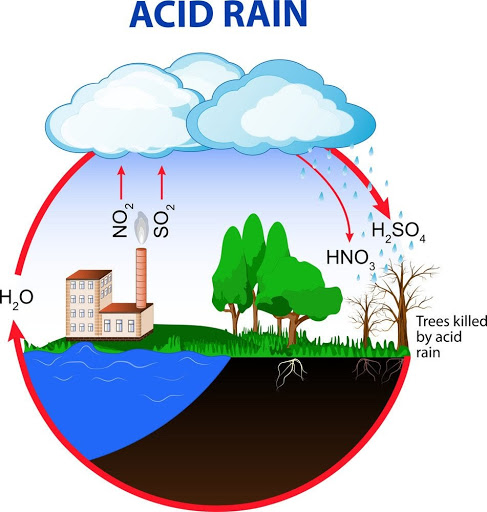
Neutralisation
Acids aur bases do chemically opposite substances hai. Jab acid ko base ke sath mix kiya jata hai toh ye ek dusre ko neutralise kar dete hai. Jab acidic solution aur basic solution ko suitable amount mein mix kiya jata hai toh yeh solution ke acidic aur basic dono natures ko destroy kar deta hai. Resulting solution na acidic hota hai na basic hota hai, yeh neutral hota hai. Acid aur base ke beech mein jo reaction hoti hai usko neutralisation reaction kehte hai.
Neutralisation reaction mein salt aur water produce hote hai aur heat evolve hoti hai. Iss reaction mein jo salt produce hota hai wo acidic, basic ya neutral hota hai. Jo heat iss reaction mein evolve hoti hai usse solution ka temperature raise hota hai.

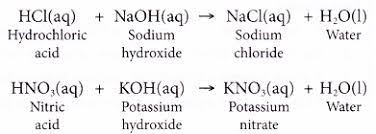
Phenolphthalein ek natural indicator hai jisko neutralisation process mein use kiya jata hai. Phenolphthalein basic solution mein pink colour deta hai aur acidic solution mein yeh colourless hota hai.
POINT 1
Acids: Acids are substances that taste sour and are corrosive in nature.
Bases: Bases are substances that, in aqueous solution, are slippery to the touch and bitter in taste.
Indicators: An indicator is a 'dye' that changes colour when it is put into an acid or a base.
Natural indicators: The indicators that are obtained from plants are known as natural indicators.
Acid rain: Acid rain is made up of highly acidic water droplets due to air emissions, most specifically the disproportionate levels of sulphur and nitrogen emitted by vehicles and manufacturing processes.
Neutralisation: The reaction in which an acid reacts with a base to form salt and water is called neutralisation.
Neutralisation in everyday life
Neutralisation reactions day to day life mein bahut important role play karte hai. Yeh indigestion aur ant sting ke treatment mein ek medicine ki tarah kaam karte hai. Inko soil treatments mein bhi use kiya jata hai. Ab kis treatment ke liye isko kaise use kiya jata hai isko hum detail mein padhenge.
Indigestion
Indigestion kyo hoti hai?Kyonki hamare stomach mein hydrochloric acid banta hai aur kabhi-kabhi jab yeh jyada amount mein produce hota hai toh indigestion ya fir acidity cause karta hai. Jab indigestion hoti hai toh hamein stomach mein irritation aur pain feel hota hai. Isko neutralise karne ke liye antacids liye jate hai, jinko base se banaya jata hai kyonki base acid ko neutralise kar deta hai aur relief milta hai. Indigestion ko relieve karne ke liye hum antacids like milk of magnesia ka use karte hai. Milk of magnesia mein magnesium hydroxide name ka ek base present hota hai. Yeh stomach mein present excess acid ko neutralise kar deta hai aur hamein indigestion se relive karta hai. Baking soda bhi antacid ka ek example hai isme sodium hydrogen carbonate name ka base present hota hai. Hum jo bhi medicines acidity ya indigestion mein use karte hai usme base present hota hai.
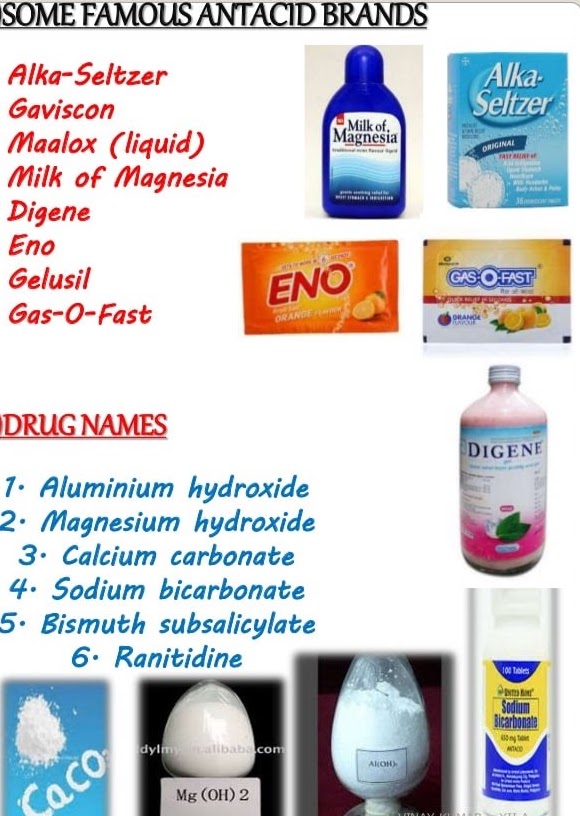
Ant bite
Jab bhi hamein ant bite kar leti hai toh hum baking soda ya calamine solution ko us jagah par rub karte hai. Kyonki jab aunt sting karti hai tab wo hamari body mein formic acid name ka acidic liquid inject karti hai jiski vajah se hamein burning sensation ya pain feel hota hai. Isko neutralise karne ke liye hum iss par base rub karte hai. Hum ant sting ko neutralise karne ke liye jo bhi remedy use karte hai usme base present hota hai. Eg- Baking soda mein sodium hydrogencarbonate present hota hai aur calamine solution mein zinc carbonate present hota hai.
Soil treatment
Soil naturally hi acidic ya basic hoti hai. Lekin agar soil jyada acidic ya jyada basic ho toh plants achhe se grow nahi karte. Isliye plants ko achhe se grow karne ke liye hamein soil ko neutral karna hota hai. Soil ki neutrality maintain rahe isliye hamein jyada fertilizers ka use nahi karna chahiye. Agar soil bahut jyada acidic hoti hai toh hum isme bases add karte hai. Bases ke kuchh examples hai- Quick lime (calcium oxide), slaked lime (calcium hydroxide), etc. Agar soil jyada basic hoti hai toh isme organic matter eg- compost add kiya jata hai. Organic matter soil mein acids release karta hai jo soil ke basic nature ko neutralise karne mein help karta hai. Lekin koi bhi soil acidic hai ya basic hai yeh hamein uska pH value check karne ke bad pata chalta hai. pH ke baare mein hum detail mein higher classes mein padhenge.Factory wastes
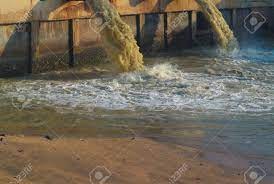
Aaj-kal bahut jyada industrialisation ho gaya hai jiski wajah se factories bahut jyada ho gayi hai. Factories mein se jo bhi waste nikalta hai wo bahut jyada acidic hota hai aur agar yeh waste water bodies mein release hota hai toh isse water bodies bhi acidic ho jati hai aur aquatic plants aur animals ki life danger mein aa jati hai. Isliye factory wastes ko water bodies mein release karne se pehle unko basic substances se treat karna chahiye taki aquatic life affect na ho.
POINT 2
Indigestion: Indigestion is also known as dyspepsia. It is the term used to describe discomfort in the stomach.
Antacid: Antacids are a group of mild bases which have no toxic effects on the body. Being basic in nature, antacids react with excess acid in stomach and neutralise it.
SUMMARY
1. Acids are sour in taste. Generally, bases are bitter in taste and soapy to touch.
2. Acid turns blue litmus red. Bases turn red litmus blue.
3. Substances which are neither acidic nor basic are called neutral.
4. Solutions of substances that show different colour in acidic, basic and neutral solutions are called indicators.
5. An acid and a base neutralise each other and form a salt. A salt may be acidic, basic or neutral in nature.
